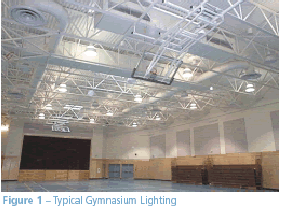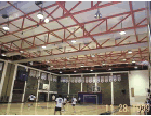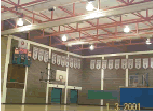ARCHIVED - Energy Efficiency in Buildings
Information Archived on the Web
Information identified as archived on the Web is for reference, research or recordkeeping purposes. It has not been altered or updated after the date of archiving. Web pages that are archived on the Web are not subject to the Government of Canada Web Standards. As per the Communications Policy of the Government of Canada, you can request alternate formats. Please "contact us" to request a format other than those available.
Lighting Options for Gymnasiums
Description
There are many different lighting system choices available for today's indoor gymnasiums (see Figure 1). This fact sheet outlines the advantages and disadvantages of the most common choices, compares some of the costs and gives pointers to help you begin designing the best lighting system for your application.
Most gymnasiums today are true multi-purpose rooms. Choosing a lighting source means determining how the room will be used. Typical lighting choices include fluorescent or metal halide lamps. Both lighting types are considered highly efficient and provide a white light that is acceptable for these areas.

Technical Specifications
Although the choice of lamp types is critical when making decisions during the design selection, the focus of this fact sheet is to review the general lighting designs. Six practical options for gymnasium applications are available:
-
400-watt metal halide, pendant-mounted, low bay-type luminaires complete with dropped spread lens and wire guard;
-
400-watt metal halide, pendant-mounted, prismatic acrylic-type luminaires complete with wire guard;
-
Double 400-watt metal halide indirect luminaires, suspended 1.2 m (4 feet) below roof deck;
-
4-lamp × 32-watt T-8 fluorescent luminaires with specular white reflector gym-type luminaire with a high ballast factor ballast;
-
2-lamp F96T12HOES fluorescent luminaires with specular white reflector industrial-type luminaire; and
-
400-watt mercury vapour, pendant-mounted, open reflector-type luminaires and wire guard. Although this type of system is no longer being installed, it is common in many gyms and provides a good comparison.
Energy Information
Table 1 presents a design simulation of these six options for a double-sized gymnasium. Note that Option 3 is the highest lighting quality option but comes with the highest energy and initial costs.
| Option | Direct1 Indirect* | Average Illumination (foot-candles) | Average Illumination (lux) | Number of Luminaires | Total Power (watts) | Annual kWh/m2 | Initial Installed Cost ($) | Estimated Annual Electrical Operating Cost ($)** |
|---|---|---|---|---|---|---|---|---|
| 1 | D | 41 | 441 | 24 | 10800 | 43.2 | 13,000 | 1,620 |
| 2 | D/I | 37 | 398 | 20 | 9000 | 36.0 | 11,000 | 1,350 |
| 3 | I | 40 | 430 | 16 x 2 | 14400 | 57.6 | 22,000 | 2,160 |
| 4 | D | 37 | 398 | 50 | 7800 | 31.2 | 16,000 | 1,170 |
| 5 | D | 37 | 398 | 38 | 9000 | 36.0 | 12,000 | 1,350 |
| 6 | D | 40 | 430 | 40 | 18000 | 72.0 | 20,000 | 2,700 |
**Refers to the primary direction of lighting from the luminaires: D = Direct (downward) and I = indirect (upward).
**Based on $0.50 per kWh and $5 per kW for 3000 hours per year.
Comparison
Table 2 describes the advantages and disadvantages of the five best lighting options over the obsolete installation (Option 6). As a point of comparison, the lighting design for the double-sized gymnasium was based on a target of 50 maintained foot-candles of illumination.
| Option | Avantages | Disadvantages |
|---|---|---|
| 1 |
– Low initial cost – Low operating cost – Easy lamp replacement |
– Éblouissement direct vif – Nombre d'ampoules peu élevé, vastes zones obscures si une lampe grille – Allumage ou rallumage lent |
| 2 |
– Lowest initial cost – High up-light component – Considered decorative – Reduced direct glare – Brighter ceiling illumination |
– Similar to Option 1 – Higher susceptibility to damage – Lamps visible from directly below |
| 3 |
– Best lighting quality – No direct luminaire glare |
– Highest initial and operating cost – Higher access required for re-lamping – Slow start or re-strike – Ceiling "hot spots" |
| 4 |
– Lowest electrical operating cost – Provides even lighting – Can operate gym with several lamps burnt out – Instant on |
– High lamp quantity requires higher labour costs to maintain – Medium initial cost to install |
| 5 |
– Lowest initial cost – Moderate up-light component – Provides even lighting |
– Long lamps require greater handling care – Luminaire has industrial look |
When making the final selection, it is important to note that a wide range of illumination may be desirable, depending on how the space is used. This can be achieved through dimming, split switching or other means. Another alternative is installing an additional system for low-level lighting requirements.
Case Study
As part of a comprehensive upgrade, the lighting system in the gymnasium of Langara College in Vancouver, British Columbia, was replaced, achieving better quality lighting with higher lighting levels and reduced energy usage. The client chose Option 2 because of the indirect “up-lighting” component and lower cost. Option 3 was preferred but was found to be too costly. The estimated results of the project retrofit are given in Tables 3 and 4 and show an improvement in lighting quantity of nearly 100 percent and annual energy savings of $1,223 based on a demand rate of $6.48 per kW and consumption savings of $0.033 per kWh.
Existing Pendant-Mounted Mercury Vapour Luminaires 
|
Retrofit Pendant-Mounted Metal Halide Luminaires (Option 2)
|
|
|---|---|---|
| Luminaire Types | Main lighting consisted of 400-W mercury highbay luminaires along with 200-W incandescent high-bays for auxiliary lighting. | New 400-W pulse-start metal halide acrylic dome high-bays and four 4-lamp strip lights using 32-W T8 lamps (for instant-on walk-through lighting). The lighting is controlled by occupancy sensors with DDC interface to reduce hours of operation. |
| Quantity | Twenty-five 400-W mercury vapour,Eight 200-W incandescent | Fifteen 400-W pulse start metal halide,Four 32-W T-8 lamps with LBF electronic ballasts |
| Total kW | 12,2 | 6,8 |
| Annual hours |
400-W mercury vapour – 4128 200-W incandescent – 4032 |
400-W metal halide – 3302 32-W T-8 lamps – 2016 |
| Total (kWh) | 52 891 | 22 982 |
| kWh/m2 | 81,3 | 35,3 |
| Foot-candles | 23 | 45 |
Table 4 – Energy and Cost Savings Comparison for Langara College Retrofit
| Savings (kW) | 5,4 kW or 44,3 % |
| Savings (kWh) | 29 909 kWh or 56,5 % |
| Annual Energy / Maintenance Savings | $ 1 223 / $ 64 |
| Installation Cost | $ 8 865 |
| Payback Period (years) | 6,9 |
Buildings Division
Office of Energy Efficiency
Natural Resources Canada
580 Booth Street, 18th floor
Ottawa ON K1A 0E4
Tel.: 877-360-5500 (toll free)
Fax: 613-947-4121
Web site
Page details
- Date modified: